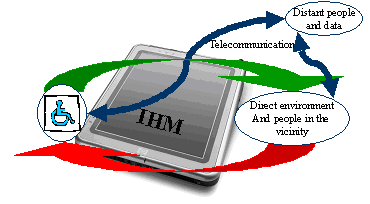
Universal human-machine interface for people with disabilities
Most assistive devices for people with disabilities are highly specialised: each one supports only a limited number of impairments. Generally, each person with a disability needs to acquire several of these systems to compensate for his or her disability(ies).
It is noted that :
- They are manufactured in small series, which leads to high costs and maintenance difficulties,
that the potential of current information processing systems is still largely under-exploited in this field. - The project consisted of defining, developing and validating a virtually universal assistance system based on widely available hardware.
The system must first and foremost ensure a two-way dialogue with the user, regardless of the latter’s disability(ies). It therefore incorporates a universal human-machine interface characterised by the following points:
- navigation in the menus and activation of the commands whatever the selected input-output interfaces,
- configuration by the user’s entourage (or by the user in some cases), – automatic detection of available peripherals,
- automatic detection of available peripherals, – contextual assistance, depending on the location or current activity.
The HMI interface developed within the framework of the project also supports a number of assistance functions:
- Sending commands: remote switching on and off of devices,
- telecommunications: telephone (mobile phone), SMS etc,
- IR remote control of HiFi devices, televisions etc,
- Support for specialised systems, e.g. Braille keyboard/display.
The software is designed in such a way that additional functions can be easily integrated (open and upgradeable system). It can be maintained to a large extent remotely (remote diagnosis and remote maintenance).
More information
Hes.so Valais – Universal Human Machine Interface for the Disabled
